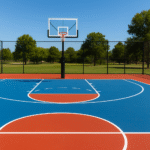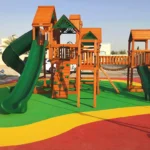Introduction
Have you ever wondered why Olympic athletes run on tracks that look identical across the globe? That’s because every Olympic size running track manufacturer follows strict standards. These tracks aren’t just about aesthetics—they’re designed for fairness, safety, and performance. From schools and universities to international sports arenas, building the right-sized track is essential for professional competition.
What is an Olympic Size Running Track manufacturer ?
An Olympic size track is a standard 400-meter running track used in all official athletic competitions. Its size, shape, and layout are governed by World Athletics (formerly IAAF). These rules ensure athletes compete under the same conditions, whether in Tokyo, Paris, or New Delhi.
Dimensions of an Olympic Size Running Track manufacturer
- Total Length: 400 meters (measured in Lane 1).
- Number of Lanes: 8 to 9 lanes (standard is 8).
- Lane Width: Each lane is 1.22 meters wide.
- Area Covered: A full-sized Olympic track requires about 176.91m x 92.5m of space.
This consistency guarantees athletes have equal opportunities, and records remain comparable worldwide.
Track Layout and Markings
The layout is a precise balance of curves and straights:
- Straights: Two stretches of 84.39 meters.
- Curves: Two semicircular bends of 115.61 meters each.
- Markings: Starting lines are staggered to adjust for curve distances.
Without accurate markings, athletes could gain unfair advantages—hence precision is key.
Materials Used in Running Track Construction
Gone are the days of dirt and cinder tracks. Today, most running track manufacturers use:
- Synthetic polyurethane flooring (most common).
- Rubberized materials for durability.
- Eco-friendly composites for sustainability.
These materials reduce injuries, improve grip, and enhance speed.
Construction Process of Olympic Size Tracks
Building a track isn’t as simple as pouring flooring. The process includes:
- Planning and site selection – choosing a flat, well-drained location.
- Base preparation – laying asphalt or concrete foundation.
- Installing running track flooring – applying polyurethane or sandwich systems.
- Line marking and finishing – adding lanes, numbers, and event-specific markings.
Every stage demands precision, which is why hiring a Running track construction service is crucial.
Running Track Flooring Options
Athletes deserve world-class surfaces. Common flooring systems include:
- Polyurethane System: Durable and weather-resistant.
- Sandwich System: Mix of granules and polyurethane layers.
- Prefabricated Flooring: Pre-made sheets installed on-site.
Each type affects athlete performance, so consulting a running track manufacturer in india helps in selecting the right option.
Running Track Manufacturer Standards
A trusted sports court manufacturer ensures compliance with World Athletics standards. Without meeting these standards, a track cannot be certified for international competitions.
Cost of Running Track Construction
The cost depends on:
- Surface type (polyurethane vs. prefabricated).
- Number of lanes.
- Site preparation needs.
- Location and labor charges.
On average, an Olympic size running track manufacturer can cost between ₹3.5 – ₹7 crore in India (or $500,000 – $1 million globally).
Why Hire Professional Court Construction Service?
Cutting corners on construction is a mistake. Professional services ensure:
- Long-lasting durability.
- Accurate measurements.
- Compliance with Olympic standards.
- Safety for athletes.
Top Benefits of Olympic Size Tracks
- Provide world-class training opportunities.
- Allow hosting of international-level competitions.
- Increase the value of a sports facility.
- Attract sponsorships and government recognition.
Difference Between Training Tracks and Olympic Size Tracks
Training tracks may be shorter or have fewer lanes. Olympic tracks, however, strictly follow 400m length and 8-lane width to meet international rules.
Maintenance of Running Tracks
Even the best flooring needs care:
- Sweep and clean regularly.
- Inspect for cracks or wear.
- Resurface every 8–10 years.
Proper maintenance extends track life and ensures athlete safety.
Challenges in Running Track Construction
Some hurdles faced during construction include:
- Weather: Rain and heat affect flooring installation.
- Budget: Quality flooring systems are expensive.
- Material Availability: Imported flooring materials may delay projects.
Future Trends in 400 meter Running Track Flooring
The future is bright with:
- Eco-friendly flooring systems.
- Advanced cushioning for injury prevention.
- Smart surfaces with embedded sensors for performance tracking.
Conclusion
An Olympic size running track is more than a sports facility—it’s a stage for dreams, records, and history. From running track manufacturers to court construction services, building the right track requires expertise, precision, and commitment to standards. Whether you’re planning a school track or a world-class stadium, always invest in quality flooring, certified materials, and professional installation. After all, the track you build today could shape the champions of tomorrow.
FAQs
1. What are the exact dimensions of an Olympic size track?
An Olympic size track is 400 meters long, with 8 lanes, each 1.22 meters wide.
2. Which material is best for running track flooring?
Polyurethane and sandwich system flooring are the most popular due to durability and performance.
3. How long does it take to construct an Olympic track?
Depending on site preparation, it usually takes 4–6 months to complete.
4. What is the average cost of running track construction?
Globally, between $500,000 – $1 million, while in India it may cost ₹3.5 – ₹7 crore.
5. Why is lane width important in Olympic tracks?
Consistent lane width ensures fairness, accurate timing, and compliance with international standards.





An Olympic sized running track is not just a venue for athletics; it’s where aspirations unfold, records are shattered, and history is made. Crafting the perfect track demands the skill of olympic size running track manufacturers and the finesse of court construction services, all driven by a dedication to excellence and adherence to the highest standards.